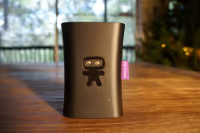
LX Group examines the Ninja Blocks system
Continuing from our previous articles which are focusing on a range of currently-available Internet-of-Things systems, we now move forward and explore another successful addition to the Internet-of-Things marketplace in more detail – the system known as “Ninja Blocks”. An Australian invention, developed only last year and originally released via the ubiquitous Kickstarter crowd funding system – Ninja Blocks are now a commercial product and available for use. It is billed as the “ Internet of things for the rest of us” – however anyone person or organisation can make good use of it.Like other systems the Ninja Blocks consist of two major elements – the hardware devices and attached I/O devices, and the software environment. Using this combination you can create sets of “rules” that allow interaction between the hardware and the end user with a variety of methods. For example temperature can be monitored remotely, alerts can be sent when a button is pressed, or an image can be emailed from the connected webcam – ideal for remote monitoring, security or personal interest applications.Furthermore the entire system is open hardware, and can be modified at whim – all the design files are available for download and examination. So creating your own devices to interact using the system is a possibility, and we can easily help you integrate your existing hardware to make use of Nina Blocks connectivity. Now let’s examine the hardware and software in more detail.Hardware – Housed inside an enclosure (that you’re encouraged to open) is a “BeagleBone”, which is a single-board Linux-based computer running a 720 MHz super-scalar ARM Cortex-A8 processor. Attached is a daughter board which contains an Arduino-compatible microcontroller and a 433 MHz wireless data link. There’s also three USB ports to connect various sensors (such as temperature, motion detectors), actuators (such as radio-controlled AC outlets) and the aforementioned USB webcam. Connection to the Internet is via a typical RJ45 connection or a Wi-Fi USB adaptor.

Included in the Ninja Blocks retail package is a wireless passive infra-red motion detector, a wireless button (similar to a doorbell button), a wireless temperature/humidity sensor and a wireless door sensor (which is a magnet/reed switch, ideal for doors and windows). This allows experimentation and a rapid method of getting familiar with the system.The wireless hardware operates in the consumer product 433 MHz frequency area, which allows integration with a wide variety of commercially-available products. If you can decode or understand the protocols used by such hardware it can be used with Ninja Blocks. For example the use of wireless AC outlets is a perfect example of how quickly (and safely) almost any device can be controlled remotely. In doing so this also removes the requirement for customised AC wiring and certification.Software – Getting started is incredibly simple, as the cloud-based environment allows you to create sets of rules that generate actions based on the data coming from the hardware. Like any other IoT system you can also create specific applications for your own needs to work with the cloud service. Further you can also update the firmware on the Arduino-compatible hardware inside the Ninja Block to allow for customised hardware interactions.Just like the hardware design, there’s no secrets to the software and the Ninja Blocks API is documented including various examples that is growing over time. Any programmer with contemporary experience can get up to speed within a reasonable amount of time. However the system can remain “code-less” as the owner can simply work with the graphical cloud interface if need be.

The Ninja Blocks system spans almost every user type, from the interested beginner to the organisation who knows what they want and doesn’t have the resources to “reinvent the wheel”. It may look like a simple product however there is a huge scope for customisation and adapting existing hardware is a genuine possibility.If you’re interested in moving forward with your own system based on the Ninja Blocks, we have existing experience with the platform, a relationship with the Ninja Blocks organisation and thus can guide you through the entire process – from understanding your needs to creating the required hardware interfaces and supplying firmware and support for your particular needs.Our goal is to find and implement the best system for our customers, and this is where the LX Group can partner with you for your success. We can create or tailor just about anything from a wireless temperature sensor to a complete Internet-enabled system for you – within your required time-frame and your budget. For more information or a confidential discussion about your ideas and how we can help bring them to life – click here to contact us, or telephone 1800 810 124.LX is an award-winning electronics design company based in Sydney, Australia. LX services include full turnkey design, electronics, hardware, software and firmware design. LX specialises in embedded systems and wireless technologies design. https://lx-group.com.auPublished by LX Pty Ltd for itself and the LX Group of companies, including LX Design House, LX Solutions and LX Consulting, LX Innovations.
.avif)